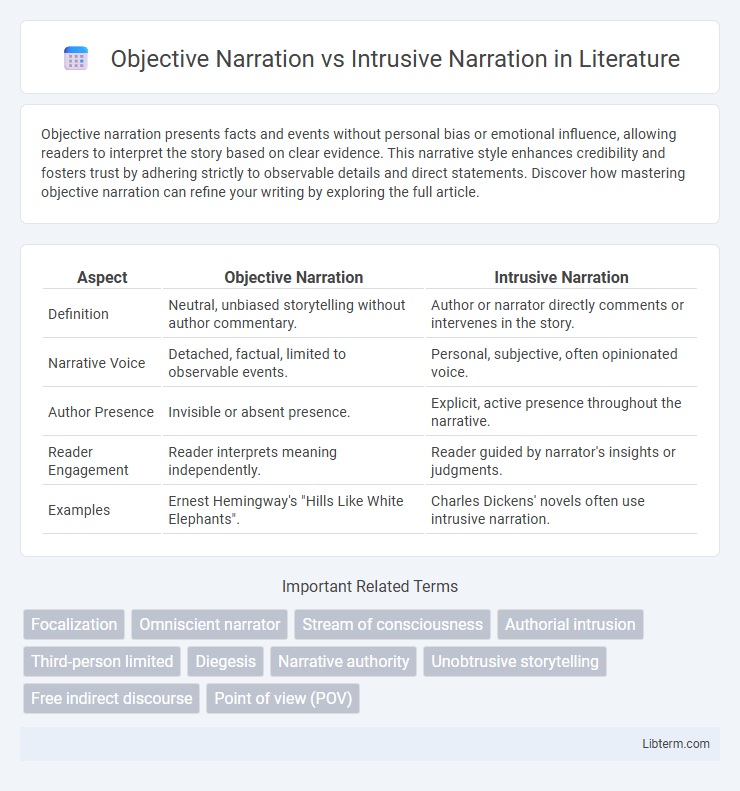Objective narration presents facts and events without personal bias or emotional influence, allowing readers to interpret the story based on clear evidence. This narrative style enhances credibility and fosters trust by adhering strictly to observable details and direct statements. Discover how mastering objective narration can refine your writing by exploring the full article.
Table of Comparison
| Aspect | Objective Narration | Intrusive Narration |
|---|---|---|
| Definition | Neutral, unbiased storytelling without author commentary. | Author or narrator directly comments or intervenes in the story. |
| Narrative Voice | Detached, factual, limited to observable events. | Personal, subjective, often opinionated voice. |
| Author Presence | Invisible or absent presence. | Explicit, active presence throughout the narrative. |
| Reader Engagement | Reader interprets meaning independently. | Reader guided by narrator's insights or judgments. |
| Examples | Ernest Hemingway's "Hills Like White Elephants". | Charles Dickens' novels often use intrusive narration. |
Understanding Objective Narration
Objective narration presents events and characters without the narrator's personal opinions or emotions, ensuring an unbiased and factual storytelling approach. This style relies on observable actions and dialogue, allowing readers to interpret the narrative independently. Understanding objective narration enhances clarity and credibility by maintaining neutrality and avoiding subjective commentary.
Defining Intrusive Narration
Intrusive narration occurs when the narrator directly addresses the reader, offering personal commentary or opinions that influence the interpretation of the story. This narrative style breaks the conventional narrative illusion by inserting subjective judgment or philosophical insights, distinguishing it from objective narration, which solely presents actions and dialogue without authorial intrusion. Intrusive narration often shapes the reader's perspective by blending storytelling with critical reflection or thematic emphasis.
Key Differences Between Objective and Intrusive Narration
Objective narration presents a neutral, unbiased account of events, allowing readers to interpret the story without authorial interruption, focusing solely on observable actions and dialogue. Intrusive narration, in contrast, features the narrator's direct commentary, opinions, and insights, guiding readers' understanding and often influencing their interpretation of the plot and characters. Key differences include the narrator's presence, with objective narration maintaining distance and detachment, while intrusive narration actively engages with the audience and shapes narrative perspective.
Historical Evolution of Narrative Styles
Objective narration evolved primarily during the 19th century with the rise of realism and modernism, emphasizing impartial and factual storytelling to depict reality without authorial bias. Intrusive narration, prominent in Victorian literature and early 20th-century works, features the author's explicit commentary, guiding readers' interpretations and reflecting narrative control. The historical evolution of these styles mirrors broader cultural shifts toward either authorial invisibility or engagement, impacting narrative techniques and reader experience.
Effects on Reader Engagement
Objective narration creates a neutral, unbiased perspective that allows readers to interpret events independently, fostering critical thinking and personal connection. Intrusive narration directly addresses the reader, guiding interpretation and enhancing emotional engagement by revealing the narrator's thoughts and opinions. Both techniques shape the reader's experience by either encouraging active participation or providing a definitive narrative lens.
Strengths of Objective Narration
Objective narration excels in presenting a clear, unbiased account of events, allowing readers to form their own interpretations based on observable actions and dialogue. Its strength lies in fostering immersive realism by maintaining narrative neutrality and avoiding authorial intrusion, which enhances credibility and reader trust. This style effectively highlights characters' behavior and environment without editorializing, making the story more engaging through subtlety and restraint.
Advantages of Intrusive Narration
Intrusive narration offers the advantage of providing direct insight into the narrator's thoughts and opinions, creating a unique connection between the reader and the narrative voice. This narrative style enhances the depth of storytelling by allowing commentary, interpretation, and emotional engagement that enrich the reader's understanding of events. It also offers flexibility for authors to shape the reader's perception and add layers of meaning beyond the objective facts.
Choosing the Right Narration for Your Story
Objective narration delivers a neutral, unbiased perspective, allowing readers to interpret events without authorial commentary, making it ideal for stories emphasizing realism and reader autonomy. Intrusive narration, characterized by the narrator's direct commentary or opinions, provides deeper insight into characters and themes, enhancing emotional engagement and thematic clarity. Choosing the right narration depends on the story's tone, desired reader involvement, and whether the author prefers subtle interpretation or explicit guidance.
Common Genres for Each Narration Style
Objective narration is commonly found in genres like journalism, documentary writing, and scientific reporting where factual accuracy and impartiality are essential. Intrusive narration often appears in literary fiction, memoirs, and certain experimental novels where the narrator's commentary, opinions, and personal voice shape the reader's experience. Each narration style aligns with specific genres to either maintain neutrality or provide subjective depth and authorial presence.
Notable Examples in Literature
Objective narration offers an impartial perspective, as seen in Ernest Hemingway's "Hills Like White Elephants," where the narrative abstains from authorial commentary, allowing readers to derive meaning from dialogue and action alone. Intrusive narration, exemplified by Charles Dickens in "Bleak House," features a narrator who openly addresses the reader, providing opinions and guiding interpretations throughout the text. These contrasting narrative styles significantly influence reader engagement and thematic development within literary works.
Objective Narration Infographic

 libterm.com
libterm.com